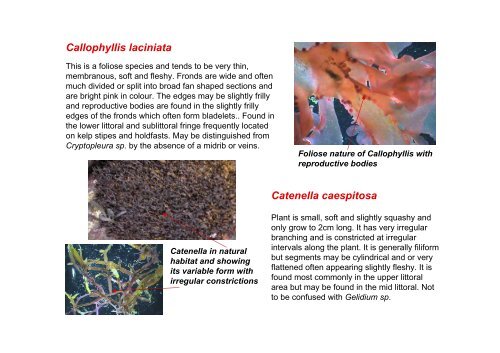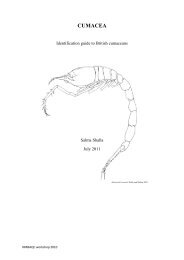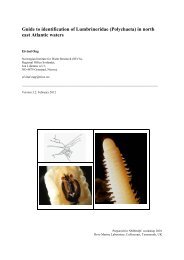s A Field Guide to the British Seaweeds - NMBAQC
s A Field Guide to the British Seaweeds - NMBAQC
s A Field Guide to the British Seaweeds - NMBAQC
Create successful ePaper yourself
Turn your PDF publications into a flip-book with our unique Google optimized e-Paper software.
Callophyllis laciniata<br />
This is a foliose species and tends <strong>to</strong> be very thin,<br />
membranous, soft and fleshy. Fronds are wide and often<br />
much divided or split in<strong>to</strong> broad fan shaped sections and<br />
are bright pink in colour. The edges may be slightly frilly<br />
and reproductive bodies are found in <strong>the</strong> slightly frilly<br />
edges of <strong>the</strong> fronds which often form bladelets.. Found in<br />
<strong>the</strong> lower lit<strong>to</strong>ral and sublit<strong>to</strong>ral fringe frequently located<br />
on kelp stipes and holdfasts. May be distinguished from<br />
Cryp<strong>to</strong>pleura sp. by <strong>the</strong> absence of a midrib or veins.<br />
Catenella in natural<br />
habitat and showing<br />
its variable form with<br />
irregular constrictions<br />
Foliose nature of Callophyllis with<br />
reproductive bodies<br />
Catenella caespi<strong>to</strong>sa<br />
Plant is small, soft and slightly squashy and<br />
only grow <strong>to</strong> 2cm long. It has very irregular<br />
branching and is constricted at irregular<br />
intervals along <strong>the</strong> plant. It is generally filiform<br />
but segments may be cylindrical and or very<br />
flattened often appearing slightly fleshy. It is<br />
found most commonly in <strong>the</strong> upper lit<strong>to</strong>ral<br />
area but may be found in <strong>the</strong> mid lit<strong>to</strong>ral. Not<br />
<strong>to</strong> be confused with Gelidium sp.




